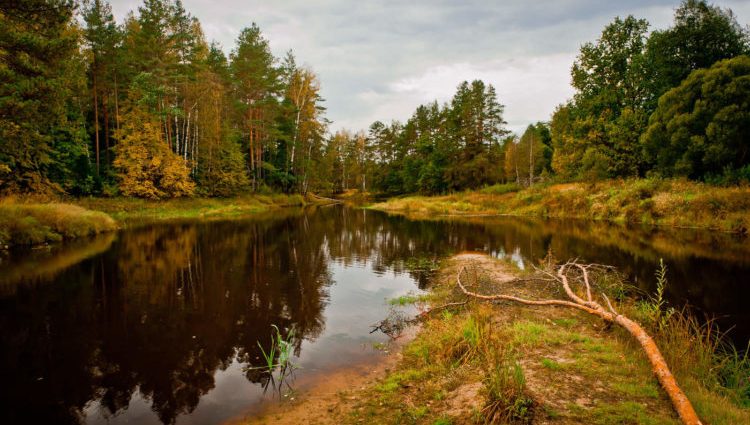Contents
The open water season is rich in trophies. Among the predators there are obvious toothy inhabitants of rivers and lakes, as well as white fish species that feed on a mixed type of food. The chub is classified as a white predator, since the fish, in addition to young shoots of plants and algae, perfectly eats crustaceans, insects and beetles, as well as fry. You can meet the chub in flowing reservoirs and, of course, in reservoirs, not far from the old riverbeds.
Chub Search Tactics
The handsome redfin hunts in the upper horizon of the water column, so it is clearly visible in polarized glasses. It is not difficult to calculate the chub: it moves in flocks of 3-5 individuals, picking up food from the surface. The chub has a prominent black tail that immediately catches the eye. This feature allows you to calculate the predator from a long distance.
If finding a chub is not so difficult, then only experienced anglers can get close to it unnoticed. Catching fish from close range is extremely difficult, because it is shy and after the first catch, the flock can simply move to another place. Just as an angler sees a predator at the surface, he also watches a person. Often, a red-haired handsome man can be observed from bridges, but he refuses the supplied baits, observing the silhouette of a person.
Promising areas for spinning fishing:
- shallow water rifts;
- narrowing of the rivers;
- exits from the pits to the shallows;
- large structures such as bridges;
- areas with hanging and fallen trees.
The chub prefers to be located near the pits where the fish goes to spend the night. During the day, flocks of the red-finned predator ply through the water area, winding many circles. The predator responds well to splashes, trying to see if anything edible has fallen into the water. This explains the quick bites after casting the bait.
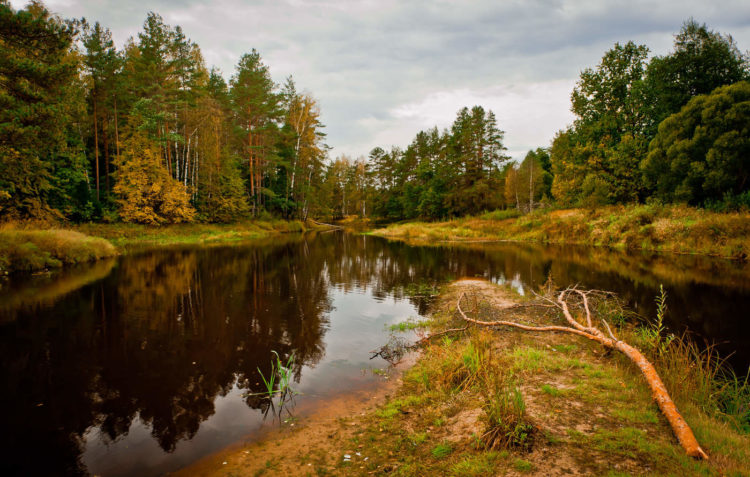
Photo: photocentra.ru
On shallow rifts, a small chub often stands, it attacks the fry that has fallen into the stream, picks up floating insects and their larvae from the surface. Large fish usually hide in the shade of trees, waiting for perch water or beetles falling from branches. The weight of a chub ranges from 0,2-1,5 kg, however, in the spring, when the fish is preparing for spawning, you can count on the capture of trophy individuals.
Chub spawning, like most representatives of the carp family, takes place in May-June, when the water temperature rises to 15℃. For spawning, fish do not go far from their habitats, picking up grassy shallow waters warmed by the sun.
In early spring, the fish is at the bottom and feeds on plant food. During this period, it is quite difficult to seduce a chub with a lure, and its capture is considered an exception. From mid-April you can search for chub in the so-called “pipes”. Pipes are narrowings of small rivers, which are characterized by a strong current. The shores can be overgrown with cattail or reeds, and also have fallen trees. Zones with blockages are an excellent habitat for the red-finned predator. There he finds both shelter and food supply (snails, insect larvae and microorganisms living on the branches of fallen trees). Active fishing begins with the departure of the May beetle, which occurs in mid-April – early May. At this time, the fish rises from the depth and picks up insects from the surface of the water.
Subtleties of fishing
To catch a white predator, you need to equip yourself with a long rod, which allows you to cast the bait over long distances. In cramped conditions, when the shore overgrown with bushes and trees does not allow you to make an accented cast, you have to be content with short blanks, carefully approaching the fish closely.
The main ways to feed the bait:
- casting across the river with the demolition of the bait to the nearest bank;
- supply of artificial bait upstream, along the near bank and overhanging trees;
- alloy of floating lures downstream with periodic winding and trajectory control.
Each promising place should be forwarded in different ways. The first step is to check the shady areas of ponds with hanging vegetation. The accuracy of casting in chub fishing plays a key role, because feeding the bait a meter left and right can deprive the angler of a wobbler or a turntable if there are a lot of bushes, snags and vegetation nearby. When the opposite bank is checked, one should proceed to the edges along the near coastline. Then you can perform 5-6 fan casts across the river, because the fish often “walks” over the pits, especially in the summer.
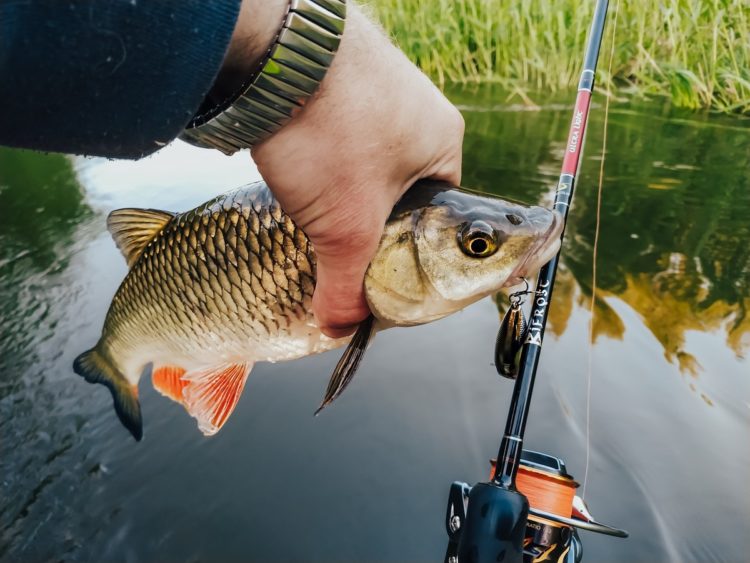
Photo: moemore.com
When fishing on ultra-light spinning rods with miniature nozzles, it makes sense to abandon direct casts by floating the wobbler downstream. It is important to control the fusion of the nozzle so that it passes close to a promising place and does not cling to obstacles. In this way, you can catch not only artificial, but also live baits: the larva of the May beetle, the beetle itself, dragonfly, etc.
Chub wiring can be:
- Monotonous, when the angler uses an ordinary broach without bellies, changing the speed of rotation of the reel.
- intermittent. Pauses are involved in this type of animation, during which floating baits rise to the surface and are carried away by the current.
- Twitchingova. Small twitches imitate the movements of real underwater inhabitants.
When catching a redfin predator, it is important to correctly feed the bait, control it with the help of current and wind. Chub fishing is complicated by the use of small loads on a strong stream. In such conditions, without fishing experience, you can be left without bites.
Spinning kit
Perhaps the most popular tackle for chub fishing is spinning. Dynamic fishing, beautiful exits of a predator and lively resistance are what anglers love this type of fishing for.
To catch a white predator, you need a rod with a test in the region of 1-10 g. Even a small chub has a strong resistance, which can be compared with the fight with an asp. The fact is that the predator lives on the current and has an elongated body shape. These two components give white predator hunters one of the most powerful river rivals.
The main characteristics of the rod:
- test load up to 10 g;
- medium or medium-fast action;
- tubular type of whip;
- comfortable handle;
- the main material is graphite.
Spinning rods with these parameters are suitable for fishing with wobblers, spoons and spinners. The tubular tip is a hollow whip made of graphite, which is the main material of the blank. Carbon fiber perfectly fulfills the strong jerks of a predator, copes with long-range casts, and is light in weight.
When buying a blank, it is important to trace the location of the rings, their quality. Chips and deformation, uneven gluing – all this is a reason to abandon the model.
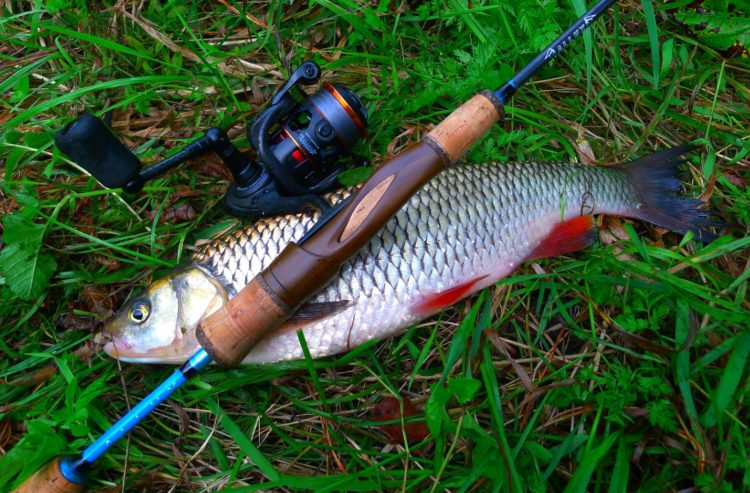
Photo: fisher.spb.ru
A spinning reel with a spool size of 1000 units is selected for the rod. Some anglers use miniature multipliers, as fishing involves catching wobblers with twitching. To fully assemble the kit, you will need a cord with a diameter of 0,08-0,1 mm. Each angler chooses the color on his own, but bright shades are not recommended, since fishing is carried out in the upper layer of the water column. There is a fluorocarbon leader between the line and the lure.
Chub Lures
For fishing, the smallest models are used, since the diet of the red-finned predator includes fry and insects. Sbirulino can be used to deliver the artificial nozzle to the perspective zone. A small bombard of a transparent color serves not only as an additional load, but also as a bite signaling device.
It is important to choose a sbirulino, taking into account the maximum test limit of the rod. The bite of a chub looks like a rattle of a float, it can often be missed if you do not pay attention to the bombard.
Wobblers

Photo: norstream.ru
Small floating models made of plastic and wood are the best option for catching a handsome redfin. The shape of the bait is compressed, reminiscent of a fet. One of the popular baits is the Strike Pro Midge, which looks like a small fish darting from side to side.
Small wobblers can be equipped with a tee, but most often they are equipped with a single hook without a beard. This allows the lure to be used as a sports alternative to conventional products.
Popular colors:
- black with bright dots;
- brown with dark back;
- dark green;
- dark with a bright tail.
The chub is a neat and cautious predator. To catch it, baits of natural colors are used, imitating beetles and fry. Many models have the anatomical shape of insects, in particular the cockchafer.
Micro pendulums

Among the effective artificial lures, there are small-sized spoons. They are made taking into account the requirements of a fastidious predator, have a pronounced game and are wound up with a half turn of the coil.
Coils have a rounded shape with an elongated front. There is a large hook in the tail of the structure, sometimes a plastic tail is attached to the winding ring. The color scheme is represented by natural and provocative shades. Bright baits are used in hot summer, when the water area begins to bloom. During this period, visibility deteriorates and anglers have no other choice but to use “acid”.
Among the bright products, trout colors are popular, which have light or dark dots on the colored body of the lure. Natural colors cover the entire dark range: green, black, brown, silver shades.
Oscillator wiring elements:
- slow pull;
- acceleration of the movement of the spinner;
- pauses up to 2 seconds;
- rod jerking.
The wiring is selected according to the place of fishing and the activity of the predator. With a good bite, a more lively and energetic game is used, with a weak one, slow wiring with grooves. At stops, the oscillator rolls over in the water column, emitting a gleam in different directions. This attracts a red-finned predator, and he goes to the lure. If the fish approaches, but refuses to attack, you should change the bait, its size and color.
Often the predator is active in the morning or late in the evening, during the day it can approach the lure, but not take it. This applies to the warm season, when the fish can be seen in the upper layers with the naked eye.
Spinners
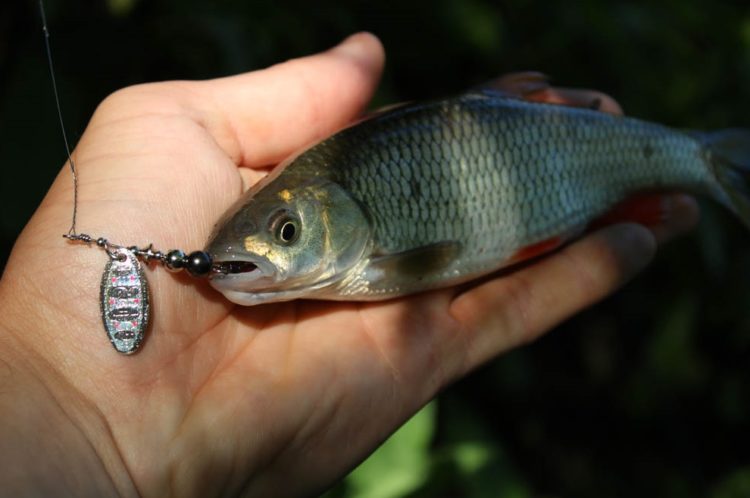
For fishing chub, it is recommended to use turntables. They are effective in the spring, when the predator is preparing to spawn. Turntables do not have long-range flight, so they can be used on small rivers or when fishing from a boat. A spinner is one of the best metal baits for fishing in shallow streams.
For hunting chub, the sizes of turntables from “00” to “2” are used. Larger bait fish attack reluctantly. Small baubles imitate the reflection of the scales of a fry, followed by a predator. The spinner can be used to check areas teeming with small fish. Even if the chub is not visible, it always stays close to the food base.
The chub does not create cauldrons like the asp or perch do, but also hunts in packs. He attacks the fry from different sides. In the spring, you can try to catch a predator not at the surface, but in the middle of the water column. Until the water warms up and the cockchafer does not fly out, the red-finned handsome man keeps lower.
Catchable turntables for catching chub:
- Mepps Aglia Long in black petal color with bright dots;
- Blue Fox with a silver tint to the petal;
- Mepps Aglia Decoree in dark colors;
- Spinner Rublex Celta in golden color;
- Lure Blue Fox Vibrax in dark tones.
Unlike pike or perch, for which spinners with a long or rounded petal are preferable, respectively, the chub is not picky about the shape and design of the spinner. It is perfectly caught on different spinners, it all depends on the activity of the predator, its quantity, weather and time of fishing.










